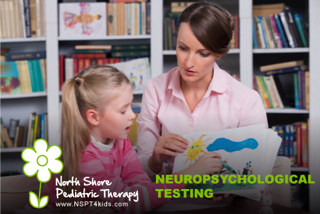Neuropsychology is a field of psychology that focuses on the relationship between learning, behavior, and brain functioning. A child may be referred for a neuropsychological evaluation when there are concerns about one or more areas of their development. This can include a child’s cognitive, academic, memory, language, social, self-regulatory, emotional, behavioral, motor, visual-spatial, and adaptive functioning.
This type of evaluation can help rule out diagnoses such as Attention Deficit/Hyperactivity Disorder, Autism Spectrum Disorder, Specific Learning Disorder, Language Disorder, as well as various emotional and behavioral disorders. A neuropsychological evaluation can also be helpful if your child has been diagnosed with a medical condition such as Down Syndrome or other genetic disorders, Traumatic Brain Injury, or Epilepsy. The purpose of the evaluation is to identify a child’s patterns of strengths and challenges in order to provide parents, schools, and other providers with strategies to help them succeed across contexts. It can also be used to track a child’s progress and response to targeted interventions.
In order to assess whether a neuropsychological evaluation may be helpful for a child, a family may identify concerns in the following areas:
Cognitive
- Difficulties with verbal and nonverbal reasoning and problem solving
- Requiring a significant amount of repetition and/or additional time when learning
- Delays in adaptive functioning
Academic
- Grades below peers
- Concerns with reading (phonetic development, fluency, comprehension), mathematics (calculation, word problems), or writing (spelling, content, organization)
- Needing additional time to complete schoolwork, homework, or tests
- Frustration with academic work
Language
- Expressive (output of language) or receptive (understanding of language) difficulties
- Challenges initiating or maintaining a conversation
- Difficulties with sarcasm or non-literal language (e.g, “It’s raining cats and dogs”)
- Repetitive or odd language usage (e.g., repeating lengthy scripts heard from television or news programs)
- Pronoun reversals or odd use of language
Self-Regulation
- Difficulty paying attention or sitting still
- Needing frequent prompts or reminders to complete tasks
- Difficulty with multiple-step commands
- Losing or misplacing items
- Forgetting to turn in completed assignments
Social
- Poor peer relations
- Inappropriate response when approached by peers
- Difficulty with imaginative, functional, or reciprocal play
- Limited interest in peers or preference for solitary play
Repetitive Behaviors
- Repetitive vocalizations
- Repetitive motor mannerisms (e.g., hand flapping, finger flicking, body rocking)
- Lining up toys, spinning wheels of cars, sorting objects for prolonged periods of time
Behavioral Dysregulation
- Physical or verbal aggression
- Defiance or non-compliance
- Difficulties with transitions or changes in routine
- Self-injury (e.g., head banging)
Emotional
- Poor frustration tolerance
- Irritability or easily upset
- Eating or sleeping difficulties
- Somatic complaints
- Negative self-statements
- Lack of interest in things he/she used to enjoy
Visual-Spatial, Visual-Motor, and Motor
- Poor handwriting
- Trouble with fine motor tasks (e.g., unwrapping small items, buttoning or zipping clothing, tying shoe laces)
- Difficulty transferring information from the classroom board to a notepad, or transferring information from a test booklet to a scantron/bubble sheet
- Difficulty with overwhelming visual displays (e.g., computer screen with several icons; homework with several problems on one sheet; a book with several colors and pictures)
Should a child demonstrate difficulties in some of the areas listed above, he/she may benefit from further consultation or a subsequent neuropsychological evaluation. Through this process, areas of difficulty can be identified, and targeted interventions will be suggested to enhance a child’s development.












